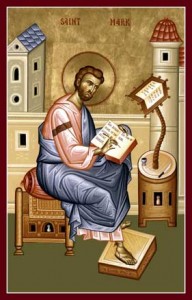As part of our 10th anniversary celebrations in 2006, some of us wrote descriptions of our journeys into Orthodoxy – the stories of our conversion to this faith and way of life. Many of these stories reveal a slow, gradual path (some with detours and tangents along the way) before we finally found the home we were searching for. These stories are a precious part of the history of our parish as well as the invaluable record of our individual lives.
The pages of holy Scripture tell similar stories. The entire Old Testament is a record of the gradual understanding of the chosen people of the working of the one true God. The New Testament, particularly, is a record of events which changed the lives of numerous people, as they came to know our Lord Jesus Christ. In the Gospels, we have been given wonderful conversion stories for our inspiration. On April 25, the Church honors one of the Gospel writers, St. Mark the Evangelist.
It is thought that Mark wrote his Gospel based on the teachings and memories of St. Peter in addition to his own first-hand knowledge. This Gospel was probably written for Christians in Rome after the martyrdom of Ss. Peter and Paul in that city (in the year 65) and shortly before the fall of Jerusalem in the year 70. In this Gospel, we hear the conversion stories of the Apostles, as Christ calls them out of their ordinary lives to participate in his ministry of teaching and healing (Mark 1:16ff). We hear of the strong belief of the woman who had the flow of blood (Mark 5:25ff), who knew that just by touching our Lord’s garment she would be healed and receive his affirmation: “Thy faith has made thee whole.” We read of blind Bartimaeus who, in faith, cried out, “Jesus, Son of David, have mercy on me” and received his sight.
Holy Scripture reveals to us some of St. Mark’s own story. The young man described in Mark 14:51-52, who came to investigate the commotion in the Garden of Gethsemane on the night of Jesus’ arrest and who ran away leaving behind his linen wrap, is thought to have been Mark himself. We hear (in Acts 12:12) that his mother was a follower of Jesus and that her home in Jerusalem was used as a meeting place for Christians. Having spent his youth immersed in the fledgling Christian community, John Mark (as he is called in these passages) was taken by his uncle Barnabas and Paul when they went to Antioch after bringing famine relief to Jerusalem (Acts 12:25). Mark then accompanied St. Paul and St. Barnabas on their first missionary journey (Acts 13:5), but Mark soon returned home to Jerusalem. For a while, Mark traveled only with Barnabas, but was eventually reunited with Paul, who described him as “useful to me for ministry” (2 Timothy 4:11). Mark also joined in the missionary efforts of St. Peter, who called him “my son.” (1 Peter 5:13).
From the writings of historians and some of the fathers of the Church, we learn other details of St. Mark’s life – how he traveled further and established churches in more distant lands, primarily in Egypt.
God had been preparing the land of Egypt for many years. Greek culture and language had existed in Egypt since the time of Alexander the Great and the large Hellenized Egyptian Jewish community had translated the Old Testament into Greek. Egypt was hallowed by the presence of the infant Jesus, his blessed Mother and St. Joseph, as they fled Herod’s massacre in Bethlehem. During the Passover observances at the time of the crucifixion and resurrection, there were undoubtedly Egyptian Jews present in Jerusalem who heard the amazing stories of Christ.
And then, around the year 49 or 50, St. Mark came to Egypt to preach the good news of salvation through Christ. The evangelist preached in the cities of Pentapolis and Medion and then established the church in Alexandria, where he remained to serve as the first bishop.
St. Mark taught both Jews and Gentiles and, despite great opposition from the rulers of the pagan temples in Egypt, Christianity began to flourish there under the care of Bishop Mark. The Liturgy in use today in Egypt is attributed to him. He founded a Christian catechetical school (which emphasized allegorical interpretation of Scripture) in Alexandria which in time rivaled the famous philosophical and scientific school and library.
Around the year 74, the great feast of Pascha fell on April 24, coinciding with the pagan Egyptian festival of the god Serapis. As the Christians gathered with their bishop in the church for the Paschal services, a huge mob also gathered for the pagan ceremonies. The mob became enraged at the Christians and they seized the bishop, bound him and dragged him through the streets to prison. Severely wounded, St. Mark had a vision of our Lord Jesus Christ that night in his prison cell. He gave thanks for the privilege of being counted worthy to endure suffering for His Name. In the morning, St. Mark received more injuries, this time fatal ones. As the crowd was preparing to burn his body in the street, a sudden, violent storm broke out and rain drenched the fire that had been set. So the Christian community was able to retrieve the body of their beloved bishop and bury him in a stone tomb. Here, they held services until 310, when a church was built over the tomb. In 828, after Islam had come to dominate Egypt, St. Mark’s relics were removed and taken to Venice and kept in the cathedral named for him there.
St. Mark’s death ended his earthly life, but the Gospel stories which he left us and the churches he established have shown the way to eternal life for countless Christians since then. We give thanks to God for the witness of St. Mark the Evangelist.
